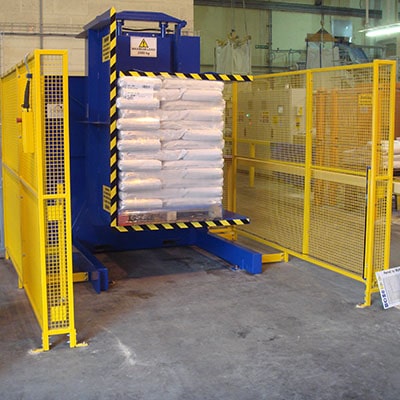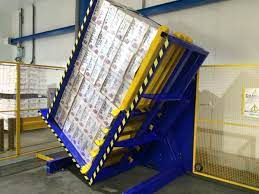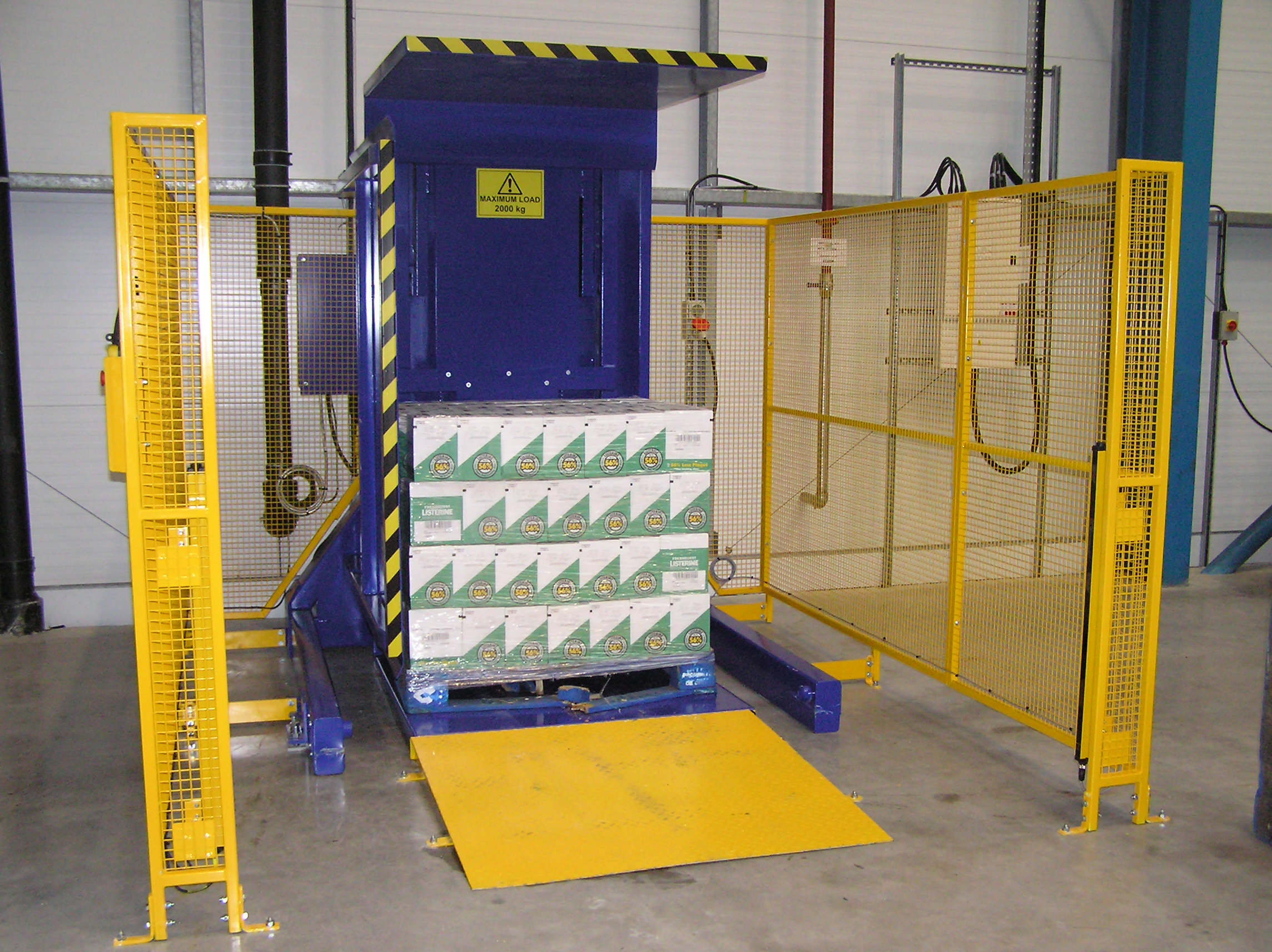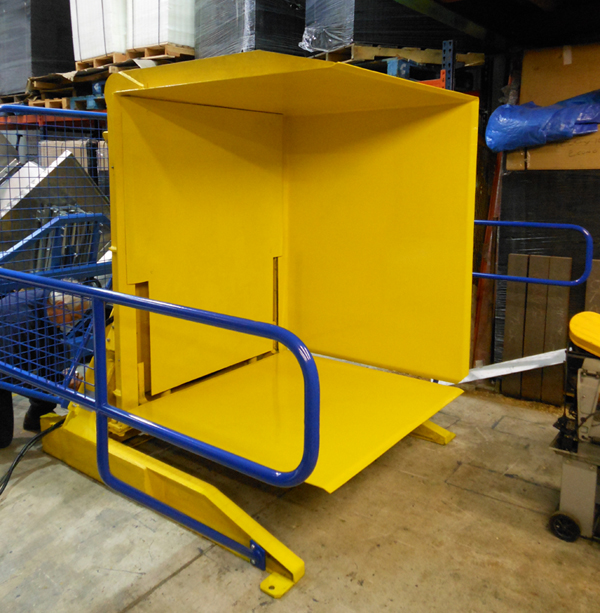Pallet Inverter: Can You Automate Pallet Swaps for High-Temperature Steel Loads?
Running a steel mill is a battle on multiple fronts. I’ve seen it firsthand with my clients. You face fluctuating energy costs, aging machinery, and constant pressure to improve efficiency. The final stage, packaging and handling, often gets overlooked. But here, manual processes for handling high-temperature loads like steel coils or billets create a serious bottleneck. This process is slow, physically demanding, and, most importantly, dangerous. Workers are exposed to extreme heat and heavy loads, leading to a high risk of injury and product damage, which eats directly into your hard-earned profits.
Yes, you can absolutely automate pallet swaps for high-temperature steel loads. This is achieved using a specialized pallet inverter designed with heat-resistant materials, a heavy-duty reinforced structure, advanced safety mechanisms, and a robust hydraulic system. These machines are engineered to operate reliably and safely in the demanding environment of a steel mill.

I know what you might be thinking. "Automation sounds great, but my operation has unique challenges. Can a machine really handle the heat and the weight?" This is a valid concern. As an engineer who has spent his entire career in this field, I can tell you that not all pallet inverters are created equal. A standard machine designed for a food or pharmaceutical warehouse would fail in days, or even hours, in your plant. But the technology has evolved. Today's machines are not just about swapping pallets; they are about creating a safer, more efficient, and more profitable workflow. Let’s explore how this technology specifically addresses the challenges of a high-temperature steel environment.
What are the key safety considerations for handling hot steel with a pallet inverter?
In any steel operation, safety isn't just a policy; it's a foundation. When you introduce new equipment, especially for handling hot, heavy loads, the first question is always about risk. You worry that an automated system might fail, causing a catastrophic spill of hot material, damaging equipment, and endangering your team. A single accident can halt production, lead to costly investigations, and ruin your company's safety record. It's a risk that keeps a plant owner like you up at night.
The most critical safety considerations for a high-temperature pallet inverter are robust heat shielding, secure and adjustable clamping systems, remote operation capabilities, and fail-safe mechanisms like interlocking gates and emergency stops. These features work together to protect both the operator and the machine from the intense heat and heavy loads.

Diving Deeper into Steel Mill Safety
When I design or recommend a system for a client in the steel industry, we don't just look at the machine's function. We perform a deep analysis of the entire process from a safety perspective. It’s not enough for the machine to work; it must work safely, even when things go wrong. Let’s break down the essential safety layers for a high-temperature pallet inverter.
Layer 1: Operator and Machine Protection
The primary goal is to isolate the operator from the hazard. In a steel mill, the main hazards are radiant heat and the potential for load instability.
- Heat Shielding: This is non-negotiable. We're not talking about a simple piece of sheet metal. Effective heat shields are often multi-layered, using materials like polished stainless steel or ceramic composites. They are strategically placed to protect critical components like hydraulic hoses, electrical wiring, and sensors from radiant heat that can degrade them over time.
- Remote Operation: Modern systems should be fully operable from a safe distance. The operator should be in a climate-controlled cabin or behind a protective barrier, using a control panel or remote pendant. This eliminates direct exposure to the hot load during the inversion cycle.
- Physical Guarding and Access Control: The entire work cell must be secured. This means physical fencing combined with safety-rated access gates. These gates are fitted with interlocking switches. If a gate is opened while the machine is active, the system immediately enters a safe state, stopping all movement.
Layer 2: Load Security and Stability
A load of hot steel billets or a coil can be incredibly unstable. The clamping system is therefore one of the most critical safety components.
| Feature | Standard Pallet Inverter | High-Temperature Steel Inverter | Safety Implication |
|---|---|---|---|
| Clamping Mechanism | Single-pressure, basic grip | Hydraulically-controlled, adjustable pressure | Prevents crushing fragile parts of the load or dropping heavy, slick ones. |
| Load Sensing | Often manual or non-existent | Integrated load cells or pressure sensors | Automatically adjusts clamping force for different loads, preventing operator error. |
| Side Walls | Open or light-duty panels | Solid, reinforced steel side walls | Contain the load completely during the 180-degree rotation, preventing any shifting or spillage. |
This level of control is crucial. I once visited a plant that tried to modify a standard inverter for their steel bars. The clamping pressure was too high and not adjustable. It ended up damaging the ends of the bars on every cycle, leading to significant scrap. A purpose-built machine avoids this by treating load security as a dynamic, controllable parameter.
How does a high-temperature pallet inverter differ from a standard model?
You understand the need for new equipment, but every investment must be justified. You might see a standard pallet inverter online for a fraction of the price of a heavy-duty model and wonder, "What am I really paying for? Can I get by with the cheaper one?" This is a dangerous line of thinking. Putting a standard machine into a high-temperature, heavy-duty application is like entering a race car in an off-road rally. It will break down quickly, cost you more in the long run, and become a massive safety liability.
A high-temperature pallet inverter is fundamentally different from a standard model in its construction materials, hydraulic and electrical systems, and structural design. It uses heat-resistant alloys, high-temperature seals and wiring, reinforced frames, and often includes cooling systems to withstand the extreme thermal and physical stress of a steel mill environment.

Diving Deeper into Engineering Differences
As an engineer, this is where my passion lies. The difference is in the details, and these details determine whether a machine will last 15 years in your plant or 15 days. A successful machine is a result of purposeful design choices made specifically for your environment. Let's compare the core components of a standard machine versus one built for a steel mill.
Structural and Material Integrity
The foundation of the machine must be solid. Steel mill equipment is subject to immense physical forces and constant thermal stress, which can cause metal fatigue over time.
- Frame Construction: A standard inverter might use 6mm or 8mm steel plates for its main structure. For a high-temperature, heavy-duty model, we start at 12mm and often go up to 20mm or more, with additional reinforcement gussets in high-stress areas like the pivot points and clamping platforms. This prevents frame warping from the heat and the weight.
- Material Science: While a standard machine uses basic carbon steel (like Q235), critical components in a high-temp inverter that are close to the load may use heat-resistant steel alloys. The clamping tables themselves might have a top layer of specialized material that can handle direct contact with hot surfaces without deforming.
System Durability: Hydraulics and Electrics
Heat is the enemy of hydraulic and electrical systems. It breaks down seals, melts wire insulation, and causes premature failure.
| Component | Standard Model Specification | High-Temperature Model Specification | Reason for the Upgrade |
|---|---|---|---|
| Hydraulic Seals | Nitrile (Buna-N) - Rated to ~100°C | Viton or other Fluoroelastomers - Rated to >200°C | Prevents hydraulic fluid leaks, which are a fire hazard and cause system failure. |
| Hydraulic Hoses | Standard rubber hoses | Hoses with braided steel reinforcement and fire-resistant sleeves | Protects against physical damage and external heat, preventing a hose burst. |
| Hydraulic Oil Cooler | Typically none | Integrated air-blast or water-based oil cooler | Keeps the hydraulic fluid at an optimal temperature, extending the life of the pump and seals. |
| Electrical Wiring | Standard PVC insulation | High-temperature Teflon or silicone insulation | Prevents wires from becoming brittle and cracking, which can cause short circuits. |
| Motors and Sensors | Standard IP54 rating | Heavy-duty, higher IP rating (e.g., IP65) and often fan-cooled | Protects against the fine, abrasive dust common in steel mills and provides better heat dissipation. |
I learned this lesson early in my career. A client bought a machine from a supplier who cut corners. They used standard hydraulic seals. Within two months, every seal had failed due to the ambient heat from the production line. The machine was down for a week, and the cost of replacing the seals and the lost production far exceeded what they "saved" on the initial purchase. This is why we don't compromise on these components.
Can automation truly handle the variability of steel mill operations?
A steel mill is a dynamic environment. Your production schedule changes based on customer orders. You might be running 1-ton coils of steel wire one day and 1.5-ton stacks of billets the next. Your biggest fear with automation is a lack of flexibility. You worry about investing in a machine that can only do one thing perfectly, creating a new problem when you need to adapt. You need a solution that can handle this inherent variability without constant reprogramming or manual intervention, which would defeat the purpose of automation.
Yes, modern automated pallet inverters are designed for flexibility. They handle operational variability using programmable logic controllers (PLCs) with pre-set recipes, integrated sensors that automatically detect different load sizes and positions, and adjustable clamping pressures. This allows them to seamlessly switch between different product types without manual adjustments.

Diving Deeper into Automation and Flexibility
Flexibility is no longer a "nice-to-have" feature; it's a core requirement of modern industrial automation. For a steel mill CEO like you, whose goal is to increase capacity utilization to 95% and deploy digital tools like an MES, the pallet inverter must be an intelligent part of that ecosystem. It can't be a dumb, repetitive machine.
The Brains of the Operation: PLC and HMI
The heart of a flexible system is its control platform.
- Programmable Logic Controller (PLC): This is the industrial computer that runs the machine. Instead of a single, fixed sequence, we program multiple "recipes." A recipe is a set of parameters for a specific product. For example:
- Recipe 1: Steel Wire Coil: Clamping pressure = 80 bar, rotation speed = 75%, centering sequence = ON.
- Recipe 2: Steel Billets: Clamping pressure = 120 bar, rotation speed = 90%, centering sequence = OFF.
- Recipe 3: Small Parts Box: Clamping pressure = 50 bar, rotation speed = 100%, centering sequence = ON.
- Human-Machine Interface (HMI): This is the touchscreen panel where the operator interacts with the PLC. The operator simply selects the correct recipe from a menu, and the machine adjusts all its parameters automatically. This is simple, fast, and eliminates human error.
The Senses of the Machine: Sensor Integration
To achieve true automation, the machine needs to be able to "see" and "feel" the load. This reduces the reliance on the operator to select the right recipe every time.
| Sensor Type | Function | How It Adds Flexibility |
|---|---|---|
| Photoelectric Sensors | Detect the presence and height of a load on the conveyor. | Automatically starts the correct cycle and can adjust the clamping table height for different load sizes. |
| Laser Distance Sensors | Measure the precise dimensions (width, length) of the incoming load. | Can automatically select the correct PLC recipe based on the load's footprint, enabling a mixed-flow production line. |
| Pressure Transducers | Monitor the real-time pressure in the hydraulic clamping circuit. | Provides feedback to the PLC to ensure the correct force is applied, preventing product damage. |
| Barcode/QR Scanners | Read a code on the pallet or product. | This is the highest level of integration. The scanner reads the product ID, communicates with your MES to get the product specs, and tells the inverter which recipe to use. |
This level of integration directly supports your goal of digitalization. The data from these sensors doesn't just run the machine; it can be fed back into your MES and data analytics platform. You can track cycle times, monitor product weights, and identify production trends, turning your packaging station into a valuable data node.
What is the real ROI of automating pallet swaps in a steel mill?
As a business owner, every decision comes down to the numbers. You see the technical benefits, but you have to answer to your bottom line. The upfront cost of a heavy-duty, automated pallet inverter is significant, and you're rightfully cautious. You might think the return on investment (ROI) is solely about replacing one or two operators, which can seem like a slow payback. But that’s a very narrow view. I’ve helped many clients through this exact analysis, and the real ROI is much broader and more impactful.
The real ROI of automating high-temperature pallet swaps extends far beyond direct labor savings. It is a composite of increased throughput, drastically improved safety which lowers insurance and compensation costs, elimination of product damage, and enhanced operational flexibility. These combined factors often lead to a payback period of less than 24 months.

Diving Deeper into Your Return on Investment
When I sit down with a client like you, I encourage them to look beyond the obvious. We build a business case that touches on every aspect of your operation that this investment will improve. Your goal to lower overall operating costs by 8% is achievable, but you have to attack costs from every angle. Let's break it down.
Quantifiable Financial Gains (The Hard ROI)
This is the data you can plug directly into a spreadsheet. Let's use a hypothetical but realistic example.
| Cost Center | Manual Process (Annual Cost) | Automated Process (Annual Cost) | Annual Savings |
|---|---|---|---|
| Labor | 2 operators x 2 shifts = 4 FTEs | 1 supervisor (part-time) = 0.5 FTE | Cost of 3.5 FTEs |
| Workplace Injuries | 1-2 minor incidents/year (lost time, claims) | 0 incidents (operator is remote) | Reduced insurance premiums, no lost time |
| Product Damage | 1% of handled product damaged | <0.1% of product damaged | Savings on scrap and rework |
| Cycle Time | 5-7 minutes per pallet swap | 90 seconds per pallet swap | Increased throughput, ability to meet demand |
| Pallet Costs | Damage to expensive in-house pallets | Extends pallet life, allows use of cheaper shipping pallets | Reduced pallet purchase/repair costs |
When you add up these numbers, the financial case becomes very compelling. The savings from injury prevention and product damage alone can sometimes justify the entire investment.
Strategic & Intangible Gains (The Soft ROI)
These are the benefits that don't show up on a P&L sheet immediately but have a massive long-term impact on your business.
- Improved Employee Morale & Retention: You can reassign skilled workers from the dangerous, repetitive task of manual handling to more value-added roles like quality control or machine maintenance. This improves job satisfaction and reduces turnover.
- Process Consistency: An automated system performs the task the exact same way every single time. This consistency improves the quality and predictability of your entire packaging process.
- Data for a Smarter Factory: As we discussed, an integrated inverter provides data. This data helps you achieve your goal of comprehensive production visualization. You can identify bottlenecks and optimize your entire workflow, not just the pallet swap.
- Future-Proofing Your Operation: This investment signals to your employees, customers, and competitors that you are a forward-thinking company committed to technology, safety, and efficiency. It enhances your brand reputation.
I once worked with a steel wire manufacturer in a situation very similar to yours. The owner was hesitant because of the initial cost. After we installed the system, he called me six months later. He said the biggest, most unexpected benefit was that his plant manager could finally focus on optimizing the production line instead of constantly dealing with staffing issues and safety incidents in the shipping area. The automation didn't just solve a single problem; it unlocked his team's potential. That is the real ROI.
Conclusion
Automating high-temperature pallet swaps is a proven, strategic investment. It directly addresses key challenges in steel production by enhancing safety, boosting efficiency, and providing the flexibility modern operations demand.



